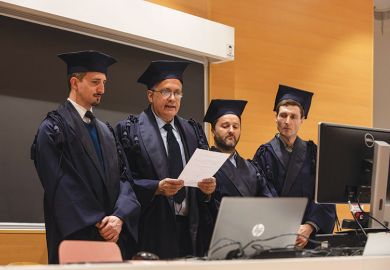With universities around the world moving their classes online in response to the coronavirus outbreak, many academics face a steep learning curve around effective online pedagogy.
At my university, we digitised part of our pre-sessional language courses for international master’s students a couple of years ago. These are the tips that our experience taught us.
1. Button down expectations. A common misconception, among managers and lecturers alike, is that people in digital learning have a big button we can press to magically make things happen online.
The reality is that just as a traditional lecture may be the fruit of months of research, 30 minutes of student-facing digital content can take hours of development time. So be realistic about how much can be produced in a short time. Staff will need remission from teaching duties if you want good quality: some to write materials, others to convert them to digital content.
2. Embrace the online difference. The default reaction of many academics is to reach for a combination of PowerPoint and screencasting software to recreate the feel of a lecture. But however lovely their voice and compelling their delivery, this is a waste of time.
PowerPoint slides don’t make great visuals, and unless the speaker is reading a script, screencasts are often full of distracting hesitations and false starts. Nor is it enough simply to transfer lecture notes to a digital platform. Be prepared to rewrite material so that it has a logical flow and is succinct enough to avoid making the screen double as an eye test.
3. Embed testing. Digital content functions best as a small series of linked learning events, with comprehension checks built into each stage. Interactive tools such as Articulate Storyline and Adobe Captivate allow lecturers to embed activities such as multiple-choice quizzes and diagram labelling. They may seem expensive, but compared with the cost of employing teachers for the same number of hours, the cost looks more reasonable. Failing this, consider open-source alternatives such as H5P and Xerte.
4. Bait the clicks. What students really want from online materials is the chance to interact. The more there is to click, the more they like it. It doesn’t matter if it is a multiple-choice question, an invitation to drag and drop summaries into the correct order, or just a button to reveal a piece of information. If all else fails, requiring students to click through several screens will give more of a sense of interaction and progress than scrolling through a single long screen of text.
5. Use templates. The more templates you can produce for your digital content creators to use and adapt, the more time you will save and the more unified your courses will look. But bear accessibility issues in mind. At a basic level, this means avoiding migraine-inducing colour combinations or ones that raise the cognitive load for dyslexic learners. Dark colours on light backgrounds generally work best.
6. Beware the Great Firewall. Some of the students accessing your materials will probably be in China. Hence, a lesson that revolves around a YouTube clip will quickly fall foul of the Great Firewall, as will anything that involves embedded Google Docs. If possible, upload any video content directly into the software.
Bear in mind, also, that not all students have superfast broadband connections. Anything involving sustained streaming runs the risk that they will encounter the spinning circle once too often and abandon the lesson.
7. Guard the broth against solo cooks. If people write, edit and publish their own materials, the resulting content will make sense to them, but possibly not to anyone else. Just like journal articles, digital content benefits from several pairs of eyes – not only logic checks by other content writers but also checks by other developers for bugs, such as dead buttons or incorrectly programmed multiple-choice questions.
8. Make feedback a learning event. Ticks and crosses show students what they got right, but they don’t reproduce the classroom opportunity to ask why something is incorrect. Adding explanations to the answers can help – including right answers, as there’s no way of knowing whether a correct response was just a lucky guess. As this can take just as long to write as the initial question, be sure to factor it into planning.
9. Don’t wish for the AI fairy. In a perfect world, teachers would set mini-essays, which an AI bot would mark and give feedback on. In the real world, programmed responses to free answers are probably unrealistic. Our solution was to provide short model answers, and to shift longer written exercises out of the digital content and on to the virtual learning environment.
10. Offer a visual guide. For students who long for the human touch/authority of a lecturer, adding an avatar to digital materials can help. Microsoft tried something similar years ago with Clippy, the sinister paper clip that answered every question apart from the one you asked, but you don’t need a crack team of animators. While packages such as Storyline have inbuilt options, a simple headshot of a tutor addressing the user via speech bubble is equally effective. And they are one more tool to help create the idea of a unified course, rather than the disparate materials you may, in reality, have been tasked with pulling together.
Nicholas Murgatroyd is a learning technologies coordinator at the English Language Teaching Centre, University of Sheffield.
Register to continue
Why register?
- Registration is free and only takes a moment
- Once registered, you can read 3 articles a month
- Sign up for our newsletter
Subscribe
Or subscribe for unlimited access to:
- Unlimited access to news, views, insights & reviews
- Digital editions
- Digital access to THE’s university and college rankings analysis
Already registered or a current subscriber?






